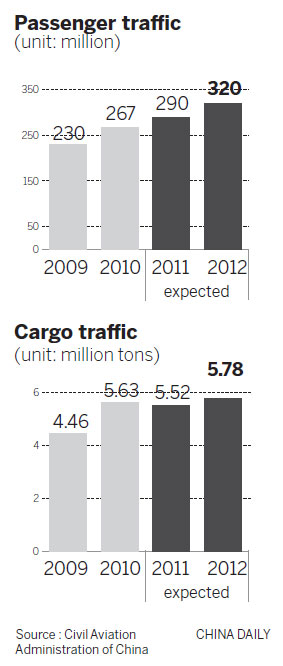China's air transporting industry slows down
Updated: 2011-12-27 08:18
By Xin Dingding (China Daily)
|
|||||||||
 |
BEIJING - China's air transport industry has registered a single-digit growth rate this year due to the global economic meltdown and domestic airspace restrictions, a top civil aviation official said.
The air transport industry achieved an estimated total air traffic (including passenger and cargo traffic) of 57.4 billion ton-kilometer this year, up 6.6 percent from that in 2010, according to statistics released by the Civil Aviation Administration of China (CAAC) on Monday.
It is the first single-digit growth since 2003 when the industry was hit by the SARS epidemic - the industry experienced double-digit growth from 2004 through 2010.
Li Jiaxiang, head of the CAAC, said at the annual working conference that the slowdown was mainly because of the global economic meltdown.
"But the growth speed is still the highest in the world, and so is the industry's total profit, estimated at 45.6 billion yuan ($7.2 billion) for 2011, which accounts for more than half of the profits of the global air transport industry," he said.
The administration had earlier planned a 13-percent rise of passenger transport and 11.5-percent growth in cargo traffic in 2011.
Li Lei, an aviation analyst with CITIC China Securities, said: "Due to the global economic downturn this year, the country's cargo transport was hit hard by the sluggish demand and has declined since May."
Meanwhile, the passenger traffic recorded only 9 percent growth due to the slowdown of domestic economy growth this year, especially compared with a rather high base last year when Shanghai held the World Expo, he said.
Li Jun, deputy head of CAAC, said that the country's sprawling high-speed rail network claimed some of the passenger traffic, and the limited airspace for civil aviation also restricted the growth of passenger transport.
As the usable airspace is unlikely to expand suddenly, the administration has been trying to tap airport capacity potentials and streamline air traffic control procedures in the past year to make it possible to add more new flights.
The administration is encouraging airlines to buy more wide-body aircraft to replace the current single-aisle planes on busy routes, especially between Beijing, Shanghai and Guangzhou, to transport more passengers in the coming year, Li Jun says.
But on the whole, the administration controls the expansion of the commercial transport fleet for the sake of safety, he adds.
China's commercial transport fleet reached a total of 1,745 aircraft, with the addition of 148 planes this year. Airlines were asked to delay the delivery of 60 new planes for which orders have been placed, he said.
"The control (on the importing of planes) will continue next year, and not more than 150 planes would be added to the fleet in 2012," he said.
Although the fleet size would not be expanded in a big way, the country's civil aviation will increase its infrastructure construction spending next year to 75 billion yuan, up from 46 billion yuan spent in 2011, he said.
The money will be used to build and expand airports, including a new airport in Beijing, he said.
Li Jiaxiang also added the nation's planning for civil airports will be adjusted in favor of building more small airports in less developed areas.
"The original plan of building 60 new airports during the 12th Five-Year Plan period (2011-2015) will be extended to 70 in order to encourage the development of local air transport," he said.
China has 180 airports at the end of 2011, up from 175 in 2010.










